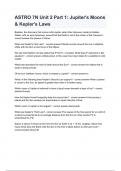Jupiter Samenvattingen, Aantekeningen en Examens
Op zoek naar een samenvatting over Jupiter? Op deze pagina vind je 665 samenvattingen over Jupiter.
Pagina 2 van de 665 resultaten
Sorteer op
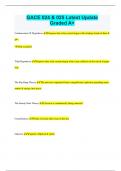
-
GACE 024 & 025 Latest Update Graded A+
- Tentamen (uitwerkingen) • 61 pagina's • 2024
-
- $11.49
- + meer info
GACE 024 & 025 Latest Update Graded A+ Condensation Of Hypothesis Proposes that solar system began with rotating clouds of dust & gas. -Widely accepted Tidal Hypothesis Proposes that solar system began with a near collision of the sun & a larger star. The Big Bang Theory The universe originated from a magnificent explosion spreading mass, matter & energy into space. The Steady State Theory Universe is continuously being renewed. Constellations Points to locate other stars i...
ASTRO 7N Unit 2 Part 1_ Jupiter's Moons & Kepler's Laws
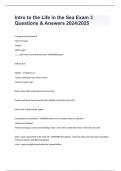
-
Intro to the Life in the Sea Exam 3 Questions & Answers 2024/2025
- Tentamen (uitwerkingen) • 21 pagina's • 2024
-
Ook in voordeelbundel
-
- $10.49
- + meer info
Intro to the Life in the Sea Exam 3 Questions & Answers 2024/2025 -Lumping of coral reefs in -limit of tropics -Jupiter -Reefs need -___ reefs have more diversity than - ANSWERStropics 30N to 30 S Jupiter - 27 degrees N -more corals than reefs (worm-rock) -reefs in Cargo Largo Reefs need mild temperatures (not too hot) Pacific reefs have more diversity than Atlantic reefs (less than 10%) Most reefs in Indo Pacific region Constraints to Coral Reefs - ANSWERS-Reefs a...
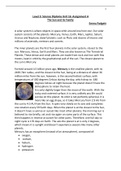
-
Unit 16 Assignment A
- Samenvatting • 47 pagina's • 2022
-
Ook in voordeelbundel
-
- $8.51
- 4x verkocht
- + meer info
Unit 16 Assignment A Overall Grade: Distinction Course Overall Grade: D*D Contains: Solar systems, Earth, Mercury, Venus, Mars, Jupiter, Saturn, Uranus, Neptune, Pluto, Ceres, Makemake, Haumea, Eris, Moons, Europa, Io, Ganymede, Titan, Big Bang theory, creation of solar system, stars, comets, life cycle of a comet, Keplers laws 1-3, compositions (C, S and M), asteroid belt, meteoroids, NASA, Oort clouds, radiation belts, gravity, sun, moon, earth, lunar months, moon cycle, solar eclipse,...
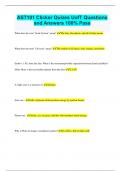
-
AST101 Clicker Quizes UofT Questions and Answers 100% Pass
- Tentamen (uitwerkingen) • 32 pagina's • 2024
-
- $9.99
- + meer info
AST101 Clicker Quizes UofT Questions and Answers 100% Pass What does the term "Solar System" mean? The Sun, the planets, and all of their moons What does the term "Universe" mean? The totality of all space, time, energy, and matter Earth is 1 AU from the Sun. What is the maximumpossible separation between Earth and Mars? (Hint: Mars is the next farthest planet from the Sun) 2.5 AU A 'light year' is a measure of: distance Stars are... balls of plasma which produce energy ...
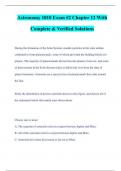
-
Astronomy 1010 Exam #2 Chapter 12 With Complete & Verified Solutions
- Tentamen (uitwerkingen) • 12 pagina's • 2023
-
- $10.49
- + meer info
During the formation of the Solar System, smaller particles in the solar nebula combined to form planetesimals, some of which provided the building blocks for planets. The majority of planetesimals did not become planets, however, and some of them remain in the Solar System today as debris left over from the time of planet formation. Asteroids are a special class of planetesimals that orbit around the Sun. Study the distribution of known asteroids shown in this figure, and choose all of t...
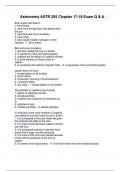
-
Astronomy ASTR 205 Chapter 17-19 Exam Q & A
- Tentamen (uitwerkingen) • 18 pagina's • 2023
-
Ook in voordeelbundel
-
- $10.00
- + meer info
Both Jupiter and Saturn 1. All of these 2. emit more energy than they absorb from the sun. 3. have belt and zone circulation. 4. have rings. 5. have liquid metallic hydrogen in their interiors. - 1. All of these Belt and zone circulation 1. has been observed only on Jupiter. 2. is caused by rising and sinking gases. 3. explains the formation of Cassini's division. 4. is more obvious on Saturn than on Jupiter. 5. is caused by the planet's magnetic field. - 2. is caused by rising a...
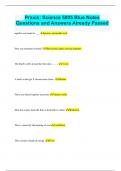
-
Praxis: Science 5005 Blue Notes Questions and Answers Already Passed
- Tentamen (uitwerkingen) • 29 pagina's • 2023
- Ook in voordeelbundel
-
- $9.99
- + meer info
Praxis: Science 5005 Blue Notes Questions and Answers Already Passed aquifers are found in ___. porous, permeable rock How are mountains formed? By tectonic plates moving together. The Earth's orbit around the Sun takes ____. 1 year A male would get X chromosome from-- Mother These are linked together in protein Amino Acids Heat that comes from the Sun to the Earth is called- Radiation This is caused by the burning of coal Acid Rain This contains chemical energy. Food Why does our body ...
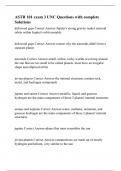
-
ASTR 101 exam 3 UNC Questions with complete Solutions
- Tentamen (uitwerkingen) • 8 pagina's • 2024
-
- $15.49
- + meer info
kirkwood gaps Correct Answer-Jupiter's strong gravity makes asteroid orbits within Jupiter's orbit unstable kirkwood gaps Correct Answer-reason why the asteroids didn't form a separate planet asteroids Correct Answer-small, airless, rocky worlds revolving around the sun that are too small to be called planets. most have an irregular shape and elliptical orbits jovian planets Correct Answer-the internal structures contain rock, metal, and hydrogen compounds jupiter and saturn Corre...
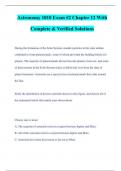
-
Astronomy 1010 Exam #2 Chapter 12 With Complete & Verified Solutions
- Tentamen (uitwerkingen) • 12 pagina's • 2023
-
Ook in voordeelbundel
-
- $9.49
- + meer info
Astronomy 1010 Exam #2 Chapter 12 With Complete & Verified Solutions During the formation of the Solar System, smaller particles in the solar nebula combined to form planetesimals, some of which provided the building blocks for planets. The majority of planetesimals did not become planets, however, and some of them remain in the Solar System today as debris left over from the time of planet formation. Asteroids are a special class of planetesimals that orbit around the Sun. Study the distribut...

Vraag jij je af waarom zoveel studenten in mooie kleren lopen, geld genoeg hebben en genieten van tonnen aan vrije tijd? Nou, ze verkopen hun samenvattingen op Stuvia! Stel je eens voor dat jouw samenvatting iedere dag weer wordt verkocht. Ontdek alles over verdienen op Stuvia

